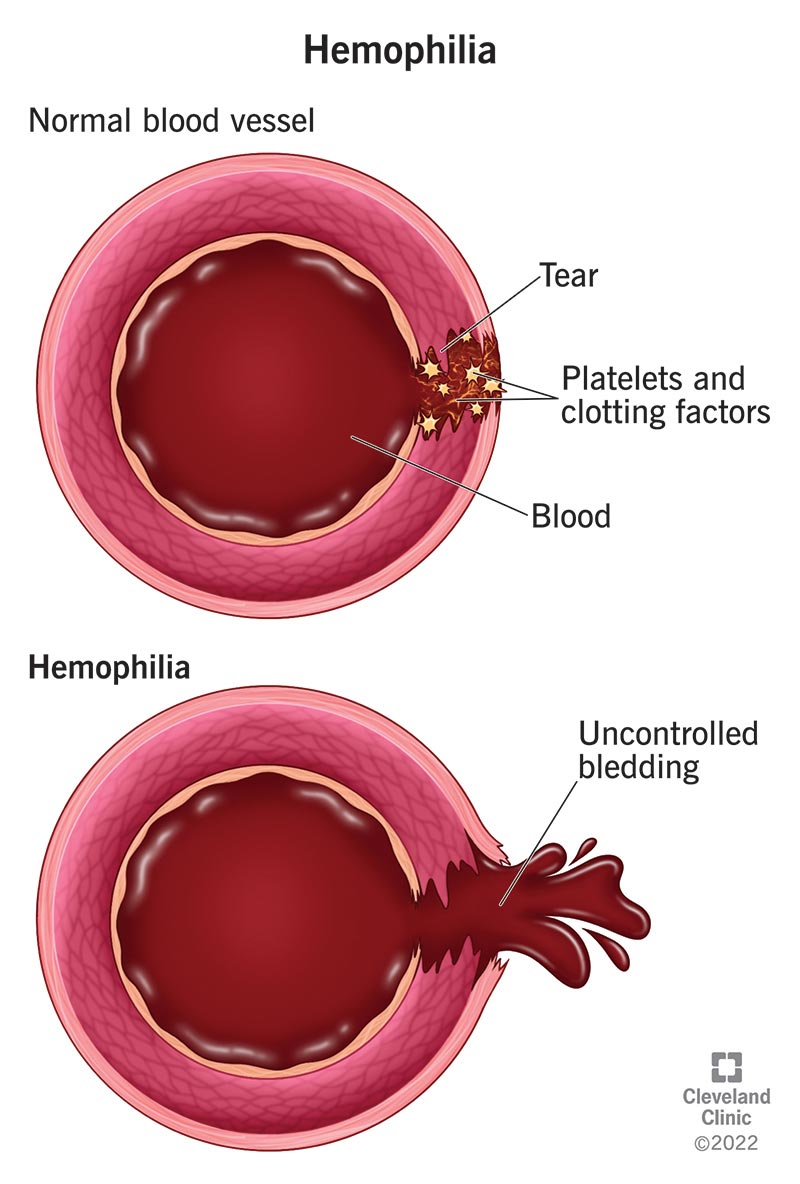A 20-year-old male patient with a known history of hemophilia A is brought to the emergency department with swelling and pain in his right knee after a minor fall. Which of the following is the most appropriate initial nursing intervention?
Prepare the patient for immediate surgical intervention.
Administer aspirin for pain relief.
Apply ice to the affected knee and elevate the leg.
Perform passive range of motion exercises on the affected knee.
The Correct Answer is C
Choice A Reason:
Preparing the patient for immediate surgical intervention is not the first-line treatment for hemophilia-related joint bleeding. Surgery is considered only if there is severe damage or if conservative measures fail. Initial management focuses on controlling bleeding and reducing inflammation.
Choice B Reason:
Administering aspirin for pain relief is contraindicated in patients with hemophilia. Aspirin inhibits platelet function and can exacerbate bleeding. Alternative pain management strategies that do not affect clotting should be used.
Choice C Reason:
Applying ice to the affected knee and elevating the leg is the most appropriate initial intervention. Ice helps to reduce swelling and pain, while elevation minimizes blood flow to the area, helping to control bleeding. This conservative approach is crucial in managing acute hemarthrosis in hemophilia patients.
Choice D Reason:
Performing passive range of motion exercises on the affected knee is not recommended during the acute phase of hemarthrosis. Movement can increase bleeding and worsen the condition. Rest and immobilization are preferred until the bleeding is controlled.

Nursing Test Bank
Naxlex Comprehensive Predictor Exams
Related Questions
Correct Answer is C
Explanation
Choice A Reason:
Preparing the patient for immediate surgical intervention is not the first-line treatment for hemophilia-related joint bleeding. Surgery is considered only if there is severe damage or if conservative measures fail. Initial management focuses on controlling bleeding and reducing inflammation.
Choice B Reason:
Administering aspirin for pain relief is contraindicated in patients with hemophilia. Aspirin inhibits platelet function and can exacerbate bleeding. Alternative pain management strategies that do not affect clotting should be used.
Choice C Reason:
Applying ice to the affected knee and elevating the leg is the most appropriate initial intervention. Ice helps to reduce swelling and pain, while elevation minimizes blood flow to the area, helping to control bleeding. This conservative approach is crucial in managing acute hemarthrosis in hemophilia patients.
Choice D Reason:
Performing passive range of motion exercises on the affected knee is not recommended during the acute phase of hemarthrosis. Movement can increase bleeding and worsen the condition. Rest and immobilization are preferred until the bleeding is controlled.

Correct Answer is A
Explanation
Choice A Reason:
Tonometry is a diagnostic test that measures the intraocular pressure (IOP) inside the eye. This measurement is crucial for detecting and managing glaucoma, as elevated IOP is a significant risk factor for the disease. By measuring the pressure, healthcare providers can assess the risk of optic nerve damage and initiate appropriate treatments to prevent vision loss.
Choice B Reason:
Tonometry does not allow for the inspection of the optic disc for signs of degeneration. This function is typically performed using ophthalmoscopy or optical coherence tomography (OCT), which provide detailed images of the optic nerve and retina. These tests are essential for evaluating the structural damage caused by glaucoma but are not part of the tonometry procedure.
Choice C Reason:
Tonometry is not performed to evaluate peripheral vision. Peripheral vision is assessed using perimetry or visual field testing, which maps the field of vision and detects areas of vision loss. This test helps determine the extent of visual impairment caused by glaucoma but is separate from tonometry.
Choice D Reason:
Tonometry does not diagnose the type of glaucoma. While it measures intraocular pressure, diagnosing the specific type of glaucoma requires a comprehensive eye examination, including gonioscopy to examine the drainage angle of the eye and other tests to assess optic nerve health and visual field. Therefore, tonometry is just one component of the diagnostic process.
Whether you are a student looking to ace your exams or a practicing nurse seeking to enhance your expertise , our nursing education contents will empower you with the confidence and competence to make a difference in the lives of patients and become a respected leader in the healthcare field.
Visit Naxlex, invest in your future and unlock endless possibilities with our unparalleled nursing education contents today
Report Wrong Answer on the Current Question
Do you disagree with the answer? If yes, what is your expected answer? Explain.
Kindly be descriptive with the issue you are facing.
